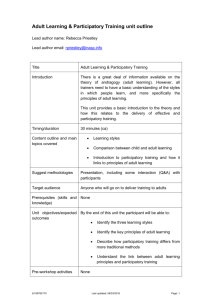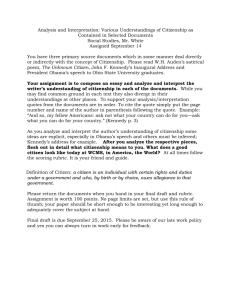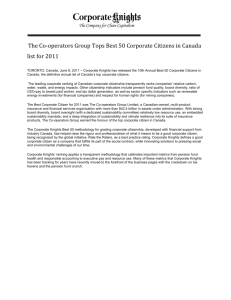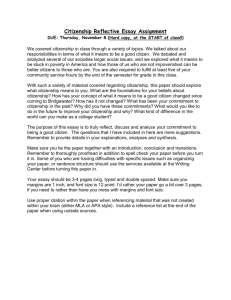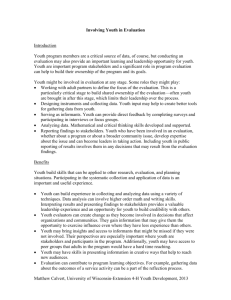Zippo
advertisement
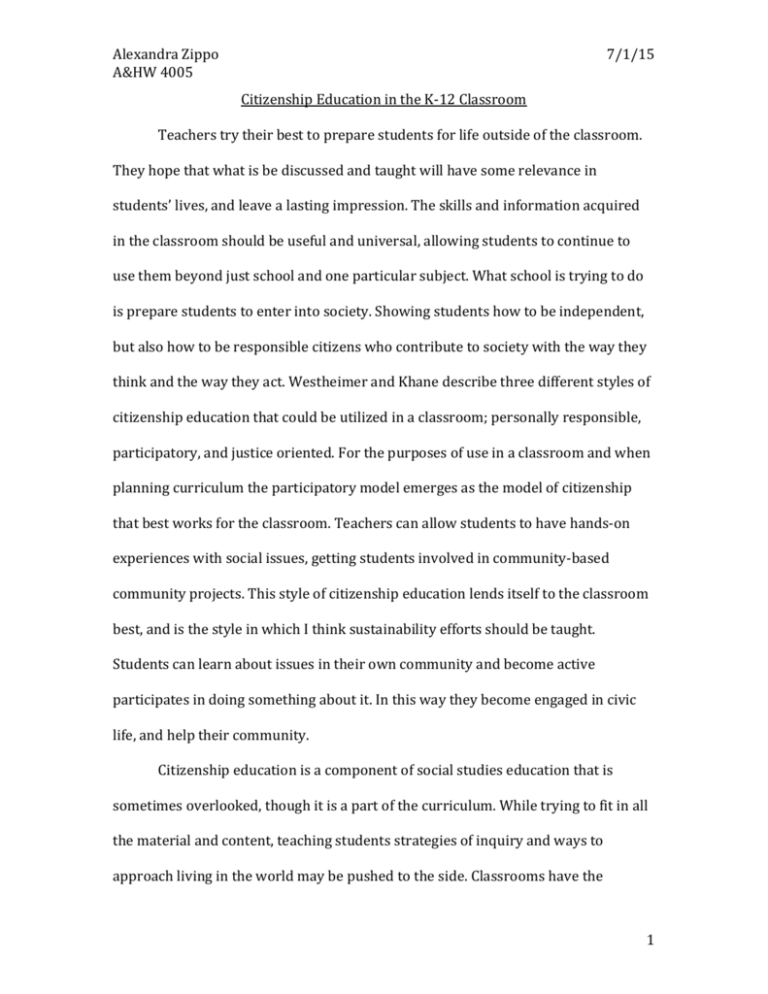
Alexandra Zippo A&HW 4005 7/1/15 Citizenship Education in the K-12 Classroom Teachers try their best to prepare students for life outside of the classroom. They hope that what is be discussed and taught will have some relevance in students’ lives, and leave a lasting impression. The skills and information acquired in the classroom should be useful and universal, allowing students to continue to use them beyond just school and one particular subject. What school is trying to do is prepare students to enter into society. Showing students how to be independent, but also how to be responsible citizens who contribute to society with the way they think and the way they act. Westheimer and Khane describe three different styles of citizenship education that could be utilized in a classroom; personally responsible, participatory, and justice oriented. For the purposes of use in a classroom and when planning curriculum the participatory model emerges as the model of citizenship that best works for the classroom. Teachers can allow students to have hands-on experiences with social issues, getting students involved in community-based community projects. This style of citizenship education lends itself to the classroom best, and is the style in which I think sustainability efforts should be taught. Students can learn about issues in their own community and become active participates in doing something about it. In this way they become engaged in civic life, and help their community. Citizenship education is a component of social studies education that is sometimes overlooked, though it is a part of the curriculum. While trying to fit in all the material and content, teaching students strategies of inquiry and ways to approach living in the world may be pushed to the side. Classrooms have the 1 Alexandra Zippo A&HW 4005 7/1/15 opportunity to challenge the way students think, push them beyond what they once knew, and have them evaluate and question what they believe in a constructive way. Instead of just reproducing a class society, teachers can make their classrooms into an “agent of transformation…with the classroom at a center of equality and democracy. (Bigelow, 1990) Teachers can employ different strategies to not only make the content of the class meaningful, but also have real world applications and be useful. Teachers can challenge students to think about the world they live in, the systems that are in place, and how to approach problematic ones. Teachers help students examine who they are, and who they could be. All of this comes with citizenship education. How do teachers engage students in the society they live in, while teaching them ways in which to impact it. This is a vital component of a proper social studies education for students, and can be applied to sustainability education. Students can examine different situations that exist, and think about how they can change them. In this way students become their own agents of change, and the teacher has accomplished their goal of creative actives citizens who contribute to society. The pr In What Kind of Citizen? Westheimer and Kahne put forth three different models for citizenship education. They weight the pros and cons of each style, giving examples of how they could be used in the classroom. This first type of citizen is the personally responsible. This type of education hopes to “build character and personal responsibility by emphasizing honesty, integrity, self-discipline and hard work.” (Westheimer& Kahne, 2004)This type of citizenship education emphasizes the individual contributions each student can make. This includes thinks such as 2 Alexandra Zippo A&HW 4005 7/1/15 recycling, giving blood, and picking up litter. Students regularly volunteer in their community and work to be a sort of model citizen. In my own education as well as students teaching experience, high schools can require a certain number of volunteer hours for graduation; which would be an example of this type of model. Students would have to spend a set number of hours doing something in their community. This type of citizenship education is beneficial in that it gives students a real sense of agency, giving clear actions they can take in order to help their local community. The personally responsibly citizen however, has its own sets of limitations. Westheimer and Kahne describe how this type of education seems to get the most attention. A reason for this may be its relative ease of implementation as opposed to the other models. In this model of education students are told to do something that contributes to their community, and choose. There is no real discussion about the source of the issue they are addressing. As an example students may help out with creating and maintaining a community garden, but wouldn’t necessarily talk about the disappearance of public green spaces local gardens as a source food for the community. Discussions about food costs for the community and where produce comes from are excluded from the conversation. Essentially students are taught to treat the symptoms of a problem without learning the systemic causes. Sustainability education may suffer from this model. Students, as a hypothetical example, may be taught how to reduce their own carbon footprint by things such as talking public transportation and re-using water bottles, but would remain mostly ignorant or the bigger them of climate change. There is also the risk that students 3 Alexandra Zippo A&HW 4005 7/1/15 may see problems they can’t fix individually as “society’s problem” and not something they should concern themselves with. This style would produce a fair amount of followers, but not leaders for the next generation. Without a fuller picture and a more complete understanding of the sustainability issues that exist, students would be going through the motions without really understanding the purpose of their actions. In these ways I think this style is insufficient in teaching students about sustainability. Another model of citizen discussed is the justice-oriented citizen. This type of education emphasizes what is missing from personally responsible, having students look for and discuss the systemic problems of the issues they are discussing. This style is very good with pursuing an inquiry-based approach, forcing students to ask questions and look for deeper meanings. These students “analyze and understand the interplay of social, economic, and political forces.” (Westheimer &Kahne, 2004) This style of education would focus less on the role of the individual and more on how to implement systematic change. The look at underlying causes of injustices and how society as a whole needs to change in order to make think more equal for everyone. According to Westheimer and Kahne this is the style that is most often overlooked in the classroom. It is a more political view of what changes should be made to society, with a focus on being able to communicate with others and weigh varying perspectives in order to come up with solutions. This style of citizenship education is difficulty in its complexity. Discovering the root causes of issues such as poverty and homelessness may be difficult for students to grapple with. Varying ideas and points of view may make it impossible 4 Alexandra Zippo A&HW 4005 7/1/15 for student progress to be distinguished, and may lead to feelings of discouragement. An example of this problem comes from my own students teaching placement. In the spring I taught in a government class for a moth, before the curriculum was switched over to economics. The style of the government class was discussion-based, and every Friday students would sit in circles and discuss issues they had been learning about earlier in the week. One of the last discussions was focused on police violence and racism, and what was to be done about it. Students all agreed that the two were linked, that racism played a role in current events at the time, which included the Trayvon Matrin story. While students agreed on this, the conversation stalled when they tried to think of solutions that could be implemented. Asking students to figure out how to combat systemic racism in America is a daunting task, and one that doesn’t have a clear-cut answer. Students eventually gave up on the discussion, felling like there was really nothing in their power to be done. This discouragement is not something that I would want to see happen in the classroom on a regular basis, and shows the major weakness of this educational strategy. The justice oriented style poses the threat of removing the individual agency that students would feel with a different type, such as personally responsible, and make them feel as if the social justice issue society is currently facing are insurmountable. Students may benefit from questioning and looking at the systemic problems, but may feel defeated if they don’t see a way to deal with what they have been discussing. With larger social issues being big, complex issues, a classroom may not be the best place for students to deal with them in more than the hypothetical. I can see problem also appearing in a sustainability framework in 5 Alexandra Zippo A&HW 4005 7/1/15 the classroom. If, for example, students were looking at the issues of environmental racism and the placement of toxic waste dumps in poor counties in Southern States, they may feel as if there is nothing they could personally do to combat the issue, and thus feel powerless to effect any sort of change. Because of this the justice oriented model of citizenship education may not be best suited for a high school class. The last style, which will prove to be the best suited for a sustainability framework in the classroom is participatory. In a participatory model the focus is on “teaching students about how government and community based organizations work and about the importance in planning and participating in organized efforts to care for those in need…” (Westheimer& Kahne, 2004) In this type of education students still retain their individual agency, but also get a more nuanced view of the issue they are addressing. The focus is creating citizens who take active roles in the community, not just by volunteering, but understanding what needs to be done and organizing the efforts themselves. This style of education can be seen as middle ground between the previous two, as it actively engages students, but pushes them to think beyond just what they themselves are doing, but what the community as a whole can be doing to improve itself. Students work to improve their immediate surroundings by creating community efforts, usually leading the efforts. This style doesn’t get to the deep societal issues of the justice oriented citizens, but my working in local efforts it serves as a stepping-stone in that direction. Once students are able to coordinate local efforts then they can take the next step to larger issues. This can combat the discouragement that may come from the justice oriented approach, as they can see local results before moving on to larger issues. 6 Alexandra Zippo A&HW 4005 7/1/15 One of the constraints of this type of education is the small scare of it. As a teacher, I want my students to have a global perspective, to see the interconnectedness of different nations and people. The justice oriented style of education is better suited for this scale of thinking, as it is trying to explore the roots of large social systems and issues, something that they two other styles don’t necessarily push students to do. In response to this criticism, the participatory framework can be seen as a step to this eventual understanding. Students can start with local issues, rooting out their causes and how to combat them, before moving on to society as a whole. Despite this shortcoming, the participatory style is still a very strong option. The participatory style is a good way to think about sustainability education, and would be most effective in the classroom. An effective sustainability curriculum focuses on realistic solutions, usually with direct participation. (Nolet, 2009) This is exactly what a participatory model offers to students. Students are tasked with coming up with solutions for local issues, and coordinating the efforts to deal with these issues. Through this students get a better understanding of their own surroundings, as well as practice in organizing people, working in groups, and balancing different thought and opinions, all skills that teachers are pushed to teach in their classrooms. In order for this to be successful students first need to be exposed to sustainability themes in the curriculum. In a history class there are plenty of examples of being able to make these connections. An example of this would be discussing the use of coal when talking about the industrial revolution, or the 7 Alexandra Zippo A&HW 4005 7/1/15 environmental impact of the urbanization that was occurring at this time. Students can first connect these themes to historical examples and case studies before being asked to grapple with the ideas for themselves. Students can examine the causes of the issues, and what was or wasn’t don't in response and the lasting effects today. Sustainability education in the regular curriculum can easily complement traditional content. According to the C3 Framework for Social Studies State Standards: “Active and responsible citizens identify and analyze public problems; deliberate with other people about how to define and address issues, take constructive and collaborative action, reflect on their actions, create and sustain groups, and influence institutions both large and small.”(C3 Framework, 2013) In order to achieve this students needs to engage in community-based, inquiry driven curriculum, the makes what they are studying not only engaging but also meaningful to their lives. The community aspect of a participatory of citizenship education is crucial for this. One of themes of suitability literacy, a framework in which teachers and students alike understand themes of sustainability, is the importance of local place. As a general trend, Americans don’t seem to think about issues that they can’t see in their everyday lives, choosing to focus on instantaneous results over a long-term view of the world. As an example, there is the issue of global warming and climate change, which most Americans think doesn’t affect them.(Craig, 2008) Students focus on their home and school communities in the participatory model. New York City is the perfect place for this type of curriculum, because it has such a rich cultural identity, and all of the neighborhoods do as well. Students can engage in community-based projects, doing research to identify sustainability issues, and create action plans that would get the entire community 8 Alexandra Zippo A&HW 4005 7/1/15 involved. By following through with this sort of project students would learn how the school system works, and also gain experience in a leadership role. An inquirybased approach would have students research and identify the issues themselves, and also come up with their own solutions. Being able to choose what to focus on, and try their own ideas of intervention would foster greater learning, and really make students agents in their own education. Choosing a meaningful place in their lives, students would create solid connections with school and community resources, coming to understand how these systems work. Once students are able to see results for their efforts on the local level they can be encouraged to start thinking on a larger scale, reaching that justice-oriented mode of thinking. The importance of local place isn’t’ to be underestimated. The participatory model of citizenship education would enable students to drive their own thinking and learning, creating projects in which each student would have a vested interest and there are visible results. Cultivating a basic understanding sustainability themes first, and establishing “sustainable literacy” will make sure students are well informed in their decision making, and focusing on local place adds authenticity to the work. The guiding learning standard for Civics, Citizenship, and Government in the New York State Common Core 9-12 Social Studies Framework is as follows: “Students will use a variety of intellectual skills to demonstrate their understanding of the necessity for establishing governments; the governmental system of the United States and other nations; the United States Constitution; the basic civic values of American constitutional democracy; and the roles, rights, and responsibilities of citizenship, including avenues of participation. “ (New York State Common Core Framework) The participatory framework purposed would be able to integrate the common core standards teachers are required to teach, while still allowing a certain degree of 9 Alexandra Zippo A&HW 4005 7/1/15 freedom to the student to make their own choices. The focus of a sustainability curriculum in this sense would center on the latter part of this standard, the responsibilities of citizenship including avenues of participation. Students would practice their research techniques, how to conduct long-term studies, how to use sources when forming their own opinions and arguments, and how to accurately and succinctly convey their thoughts and opinions to others. Group-work is also a major component of this type of curriculum, as students in the participatory role would learn to organize community efforts, not just take part in them. Public schools are presented with limitations in how they can deliver instruction because of all the teachers have to accomplish. Standardized test preparation takes up a considerable about of time, leaving little time for deviation. The participatory model is idea because it practices skills students are required to learn, while being able to make clear connections with other areas of content. In an ideal setting the participatory model isn’t restrained just to the social studies classroom, but informs crossdisciplinary instruction. Students can learn about the science behind their sustainability projects. In English students can reflect on their progress and how their proposed interventions are working. To reinforce the ideas, and show that the skills are transferable a collaborative approach between teachers would best serve the students. Along with teaching students the ways in which to participate and become involved in the school community, a participatory curriculum also tries to instill in students the obligation to do so. Being active members of society as adults is the ultimate goal, and it begins in the classroom with citizenship education. In this 10 Alexandra Zippo A&HW 4005 7/1/15 settings students learn not only the skills they need to enact change, but are encouraged to foster the feeling that this is the sort of action they should continue with later in life. Students can learn from their experiences in school, and continue to go. The fundamental understanding of what it means to be a participatory citizen, will be instilled through practice in school, and will hopefully stick with students for the rest of their lives. The real draw of this style of citizenship education over the others is the sense of accomplishment it can offer students. Instead of just doing something as a personally responsible citizen, students can feel responsible for coordinating a community-based effort, and will have a better understanding of how such processes work. The work students would be doing would be engaging, meaningful and relevant, making sure that students will remember their efforts and be more likely to replicate them in the future. Westheimer and Kahne propose three types of citizenship education that can be introduced into a classroom, personally responsible, participatory, and justice oriented. Personally responsible education focuses on efforts of the individual, participatory has more of a community-based approach, and justice oriented has a more global scope. Each of these styles of instruction has its merits, but for the purposes of a classroom, the participatory framework is best suited. The personally responsible give students an incomplete picture of the current sustainability and environmental issues they would be taking on. The justice oriented style is large in scale, and complex, making the actions that students could take seem almost pointless, and runs the risk of discouraging any sort of active participation. Thus, the participatory model of citizenship education is the best fit for a classroom 11 Alexandra Zippo A&HW 4005 7/1/15 environment, as it is local enough to be obtainable to students, but still have the critical thinking and questioning elements to have students examine the issues thoroughly. In terms of applying it to a sustainability curriculum, students would be able to engage in a strenuous inquiry-based approach to learning that involved group work, as well as a host of other skills. With a solid foundation in sustainability themes, students can work with their local residential and school communities to make them more environmentally conscious. Students become agents of their own learning, and create lasting results they can see for years to come. The hope is that by engaging in such practices in school, students will gain a deep understanding of what it means to be a participatory citizen in society, and continue to act in this way far beyond the classroom. The participatory citizen is someone who is active in their local community, who works to better understand the way organizations work, and how they can contribute. For the purposes of a classroom framework of sustainability, this is the ideal type of citizen. Students gain a critical consciousness of sustainability and environmental issues, working to improve things for everyone. An inquiry-based classroom approach that focuses on local place is how I feel sustainability efforts should be taught. Sources Cited Bigelow, W. (1990). Inside the Classroom: Social Vision and Critical Pedagogy. Teachers College Record, 91(3), 437. Retrieved from https://moodle2.tc.columbia.edu/pluginfile.php/243764/mod_resource/content/1 /bigelow.pdf Craig, D. (2008). The Deep Sleep. 16. Retrieved from http://gcafh.org/edlab/Craig.pdf 12 Alexandra Zippo A&HW 4005 7/1/15 Nolet, V. (2009). Preparing Sustainability-Literate Teachers. Teachers College Record, 11(2), 432. Retrieved from http://gcafh.org/edlab/Nolet.pdf Westheimer, J., & Kahne, J. (2004). What kind of citizen? Political choices and educational goals. American Educational Research Journal, 41(2), 3. Retrieved from http://gcafh.org/edlab/Westheimer_Kahne.pdf The College, Career, and Civic Life (C3) Framework for Social Studies State Standards: Guidance for Enhancing the Rigor of K-12 Civics, Economics, Geography, and History. (2013). 19. Retrieved from http://www.socialstudies.org/system/files/c3/C3-Framework-for-SocialStudies.pdf New York State Common Core 9-12 Social Studies Framework. 6. Retrieved from http://www.esboces.org/cms/lib07/NY01914091/Centricity/Domain/69/ES%20s s-framework-9-12.pdf 13


